
War dog
Encyclopedia

Ancient history
Ancient history is the study of the written past from the beginning of recorded human history to the Early Middle Ages. The span of recorded history is roughly 5,000 years, with Cuneiform script, the oldest discovered form of coherent writing, from the protoliterate period around the 30th century BC...
. From 'war dogs' trained in combat to their use as scouts, sentries and trackers, their uses have been varied and some continue to exist in modern military usage.
History
War dogs were used by the EgyptiansEgyptians
Egyptians are nation an ethnic group made up of Mediterranean North Africans, the indigenous people of Egypt.Egyptian identity is closely tied to geography. The population of Egypt is concentrated in the lower Nile Valley, the small strip of cultivable land stretching from the First Cataract to...
, Greeks
Greeks
The Greeks, also known as the Hellenes , are a nation and ethnic group native to Greece, Cyprus and neighboring regions. They also form a significant diaspora, with Greek communities established around the world....
, Persians, Sarmatians
Sarmatians
The Iron Age Sarmatians were an Iranian people in Classical Antiquity, flourishing from about the 5th century BC to the 4th century AD....
, Alans
Alans
The Alans, or the Alani, occasionally termed Alauni or Halani, were a group of Sarmatian tribes, nomadic pastoralists of the 1st millennium AD who spoke an Eastern Iranian language which derived from Scytho-Sarmatian and which in turn evolved into modern Ossetian.-Name:The various forms of Alan —...
, Slavs, Britons, and the Romans
Ancient Rome
Ancient Rome was a thriving civilization that grew on the Italian Peninsula as early as the 8th century BC. Located along the Mediterranean Sea and centered on the city of Rome, it expanded to one of the largest empires in the ancient world....
.
The Molossian 'Canis Molossus' dog of Epirus
Epirus
The name Epirus, from the Greek "Ήπειρος" meaning continent may refer to:-Geographical:* Epirus - a historical and geographical region of the southwestern Balkans, straddling modern Greece and Albania...
was the strongest known to the Romans, and was specifically trained for battle.
However, when fought against the broad-mouthed, powerful mastiff
Pugnaces Britanniae
The Roman Province of Britannia was known for exporting dogs. The references by Roman writers to these dogs suggest that British dogs were both fast and strong, useful in hunting and even in war...
of Britannia
Roman Britain
Roman Britain was the part of the island of Great Britain controlled by the Roman Empire from AD 43 until ca. AD 410.The Romans referred to the imperial province as Britannia, which eventually comprised all of the island of Great Britain south of the fluid frontier with Caledonia...
, they were outmatched. The Romans exported many of this breed of mastiff to Rome and then disseminated them over the known world. Often war dogs would be sent into battle with large protective spiked metal collars and coats of mail
Mail (armour)
Mail is a type of armour consisting of small metal rings linked together in a pattern to form a mesh.-History:Mail was a highly successful type of armour and was used by nearly every metalworking culture....
armor. The Romans had attack formations made entirely of dogs. Native American
Native Americans in the United States
Native Americans in the United States are the indigenous peoples in North America within the boundaries of the present-day continental United States, parts of Alaska, and the island state of Hawaii. They are composed of numerous, distinct tribes, states, and ethnic groups, many of which survive as...
s also used dogs, though not on this scale.
During the Late Antiquity
Late Antiquity
Late Antiquity is a periodization used by historians to describe the time of transition from Classical Antiquity to the Middle Ages, in both mainland Europe and the Mediterranean world. Precise boundaries for the period are a matter of debate, but noted historian of the period Peter Brown proposed...
, Attila the Hun
Attila the Hun
Attila , more frequently referred to as Attila the Hun, was the ruler of the Huns from 434 until his death in 453. He was leader of the Hunnic Empire, which stretched from the Ural River to the Rhine River and from the Danube River to the Baltic Sea. During his reign he was one of the most feared...
used giant Molosser
Molosser
Molosser is a category of large, solidly-built dog that includes several breeds, probably all descended from the same root stock. The name derives from Molossia, a subregion of ancient Epirus, ancient Greece, where the large shepherd dog was known as the Molossus.The proper noun "Mastiff", however,...
dogs in his campaigns. Gifts of war dog breeding stock between European royalty
Royal family
A royal family is the extended family of a king or queen regnant. The term imperial family appropriately describes the extended family of an emperor or empress, while the terms "ducal family", "grand ducal family" or "princely family" are more appropriate to describe the relatives of a reigning...
were seen as suitable tokens for exchange throughout the Middle Ages. Other civilizations used armored dogs to defend caravans or attack enemies. The Spanish conquistadors used armoured dogs that had been trained to kill and disembowel when they invaded the land controlled by South America
South America
South America is a continent situated in the Western Hemisphere, mostly in the Southern Hemisphere, with a relatively small portion in the Northern Hemisphere. The continent is also considered a subcontinent of the Americas. It is bordered on the west by the Pacific Ocean and on the north and east...
n natives.
The British used dogs when they attacked the Irish
Ireland
Ireland is an island to the northwest of continental Europe. It is the third-largest island in Europe and the twentieth-largest island on Earth...
and the Irish in turn used Irish Wolfhound
Irish Wolfhound
The Irish wolfhound is a breed of domestic dog , specifically a sighthound. The name originates from its purpose rather than from its appearance...
s to attack invading Norman
Normans
The Normans were the people who gave their name to Normandy, a region in northern France. They were descended from Norse Viking conquerors of the territory and the native population of Frankish and Gallo-Roman stock...
knights on horseback. Two wolfhounds, or even a single one were often capable of taking a mounted man in armour off his horse, where the lightly armed handler would finish him off
Coup de grâce
The expression coup de grâce means a death blow intended to end the suffering of a wounded creature. The phrase can refer to the killing of civilians or soldiers, friends or enemies, with or without the consent of the sufferer...
if necessary.
Later on, Frederick the Great
Frederick II of Prussia
Frederick II was a King in Prussia and a King of Prussia from the Hohenzollern dynasty. In his role as a prince-elector of the Holy Roman Empire, he was also Elector of Brandenburg. He was in personal union the sovereign prince of the Principality of Neuchâtel...
used dogs as messengers during the Seven Years' War
Seven Years' War
The Seven Years' War was a global military war between 1756 and 1763, involving most of the great powers of the time and affecting Europe, North America, Central America, the West African coast, India, and the Philippines...
with Russia. Napoleon
Napoleon I of France
Napoleon Bonaparte was a French military and political leader during the latter stages of the French Revolution.As Napoleon I, he was Emperor of the French from 1804 to 1815...
would also use dogs during his campaigns. Dogs were used up until 1770 to guard naval installations in France.
The first official use of dogs for military purposes in the United States was during the Seminole Wars
Seminole Wars
The Seminole Wars, also known as the Florida Wars, were three conflicts in Florida between the Seminole — the collective name given to the amalgamation of various groups of native Americans and Black people who settled in Florida in the early 18th century — and the United States Army...
. The American Pit Bull Terrier was used in the American Civil War
American Civil War
The American Civil War was a civil war fought in the United States of America. In response to the election of Abraham Lincoln as President of the United States, 11 southern slave states declared their secession from the United States and formed the Confederate States of America ; the other 25...
to protect, send messages, and as mascots in American World War I propaganda and recruiting posters.
Historical examples
The use of dogs in warfare has been common even in many early civilizations. As warfare has progressed, their purposes have changed greatly. Some examples are:- 628 BC: The LydiansLydiansThe Lydians were the inhabitants of Lydia, a region in western Anatolia, who spoke the distinctive Lydian language, an Indo-European language of the Anatolian group....
deployed a separate battalion of fighting dogs. - 525 BC: Cambyses II used huge fighting dogs against Egyptian spearmen and archers.
- 490 BC: Battle of MarathonBattle of MarathonThe Battle of Marathon took place in 490 BC, during the first Persian invasion of Greece. It was fought between the citizens of Athens, aided by Plataea, and a Persian force commanded by Datis and Artaphernes. It was the culmination of the first attempt by Persia, under King Darius I, to subjugate...
: A brave fighting dog was immortalized in a mural. - 385 BC: Siege of Mantineia: Fighting dogs cut off enemy reinforcements.
- 101 BC: Battle of VercellaeBattle of VercellaeThe Battle of Vercellae, or Battle of the Raudine Plain, in 101 BC was the Roman victory of Consul Gaius Marius over the invading Germanic Cimbri tribe near the settlement of Vercellae in Cisalpine Gaul....
: Large CimbriCimbriThe Cimbri were a tribe from Northern Europe, who, together with the Teutones and the Ambrones threatened the Roman Republic in the late 2nd century BC. The Cimbri were probably Germanic, though some believe them to be of Celtic origin...
dogs led by women defended their wagon fortWagon fortA Laager, also known as a wagon fort, is a mobile fortification made of wagons arranged into a rectangle, a circle or other shape and possibly joined with each other, an improvised military camp....
s. - 1525: Henry VIIIHenry VIII of EnglandHenry VIII was King of England from 21 April 1509 until his death. He was Lord, and later King, of Ireland, as well as continuing the nominal claim by the English monarchs to the Kingdom of France...
exported 400 mastiffsEnglish MastiffThe English Mastiff, referred to by virtually all Kennel Clubs simply as the Mastiff, is a breed of large dog perhaps descended from the ancient Alaunt through the Pugnaces Britanniae. Distinguishable by enormous size, massive head, and a limited range of colors, but always displaying a black mask,...
to support SpainSpainSpain , officially the Kingdom of Spain languages]] under the European Charter for Regional or Minority Languages. In each of these, Spain's official name is as follows:;;;;;;), is a country and member state of the European Union located in southwestern Europe on the Iberian Peninsula...
. - 1580: Elizabeth IElizabeth I of EnglandElizabeth I was queen regnant of England and Ireland from 17 November 1558 until her death. Sometimes called The Virgin Queen, Gloriana, or Good Queen Bess, Elizabeth was the fifth and last monarch of the Tudor dynasty...
sent 800 fighting dogs to fight in the Desmond RebellionsDesmond RebellionsThe Desmond Rebellions occurred in 1569-1573 and 1579-1583 in the Irish province of Munster.They were rebellions by the Earl of Desmond – head of the FitzGerald dynasty in Munster – and his followers, the Geraldines and their allies against the threat of the extension of Elizabethan English...
. - 1799: NapoleonNapoleon INapoleon Bonaparte was a French military and political leader during the latter stages of the French Revolution.As Napoleon I, he was Emperor of the French from 1804 to 1815...
assembled large numbers of fighting dogs in front of his reserves. - 1914: The Belgian ArmyBelgian ArmyThe Land Component is organised using the concept of capacities, whereby units are gathered together according to their function and material. Within this framework, there are five capacities: the command capacity, the combat capacity, the support capacity, the services capacity and the training...
used carabiniers, strong-muscled Bouvier des FlandresBouvier des FlandresThe Bouvier des Flandres is a herding dog breed originating in Flanders. They were originally used for general farm work including cattle droving, sheep herding, and cart pulling, and nowadays as guard dogs and police dogs, as well as being kept as pets. The French name of the breed means,...
to haul heavy machine gunMachine gunA machine gun is a fully automatic mounted or portable firearm, usually designed to fire rounds in quick succession from an ammunition belt or large-capacity magazine, typically at a rate of several hundred rounds per minute....
s to the front. - 1914–1918: Dogs were used by international forces to deliver vital messages.
- 1941–1945: The Soviet UnionSoviet UnionThe Soviet Union , officially the Union of Soviet Socialist Republics , was a constitutionally socialist state that existed in Eurasia between 1922 and 1991....
used dogs strapped with explosivesAnti-tank dogAnti-tank dogs were dogs taught to carry explosives to tanks, armored vehicles and other military targets. They were intensively trained by the Soviet and Russian military forces between 1930 and 1996 and used in 1941–1942 against German tanks in World War II...
to destroy invading German tanks. - 1943–1945: The United States Marine CorpsUnited States Marine CorpsThe United States Marine Corps is a branch of the United States Armed Forces responsible for providing power projection from the sea, using the mobility of the United States Navy to deliver combined-arms task forces rapidly. It is one of seven uniformed services of the United States...
used dogs, donated by their American owners, in the Pacific theaterPacific WarThe Pacific War, also sometimes called the Asia-Pacific War refers broadly to the parts of World War II that took place in the Pacific Ocean, its islands, and in East Asia, then called the Far East...
to help take islands back from Japanese occupying forces. During this period the Doberman Pinscher became the official dog of the U.S.M.C.; however, all breeds of dogs were eligible to train to be "war dogs of the Pacific". Of the 549 dogs that returned from the war, only 4 could not be detrained and returned to civilian life. Many of the dogs went home with their handlers from the war. - 1966–1973: Approximately 5,000 US war dogs served in the Vietnam WarVietnam WarThe Vietnam War was a Cold War-era military conflict that occurred in Vietnam, Laos, and Cambodia from 1 November 1955 to the fall of Saigon on 30 April 1975. This war followed the First Indochina War and was fought between North Vietnam, supported by its communist allies, and the government of...
(the US ArmyUnited States ArmyThe United States Army is the main branch of the United States Armed Forces responsible for land-based military operations. It is the largest and oldest established branch of the U.S. military, and is one of seven U.S. uniformed services...
did not retain records prior to 1968); about 10,000 US servicemen served as dog-handlers during the war, and the K9 units are estimated to have saved over 10,000 human lives. 232 military working dogs and 295 US servicemen working as dog handlers were killed in action during the war. It is estimated that about 200 Vietnam War dogs survived the war to be assigned at other US bases outside the US. The remaining canines were euthanized or left behind. - 1979–1988: The Soviet Union again used dogs, this time in the Soviet war in AfghanistanSoviet war in AfghanistanThe Soviet war in Afghanistan was a nine-year conflict involving the Soviet Union, supporting the Marxist-Leninist government of the Democratic Republic of Afghanistan against the Afghan Mujahideen and foreign "Arab–Afghan" volunteers...
. - 2011: United States Navy SEALsUnited States Navy SEALsThe United States Navy's Sea, Air and Land Teams, commonly known as Navy SEALs, are the U.S. Navy's principal special operations force and a part of the Naval Special Warfare Command as well as the maritime component of the United States Special Operations Command.The acronym is derived from their...
used a Belgian MalinoisBelgian Shepherd Dog (Malinois)The Belgian Shepherd Dog is a breed of dog, sometimes classified as a variety of the Belgian Shepherd Dog rather than as a separate breed. The Malinois is recognized in the United States under the name Belgian Malinois...
war dog named Cairo in Operation Neptune Spear, in which Osama bin Laden was killedDeath of Osama bin LadenOsama bin Laden, then head of the Islamist militant group al-Qaeda, was killed in Pakistan on May 2, 2011, shortly after 1 a.m. local time by a United States special forces military unit....
.
Roles
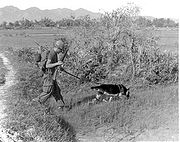
Dog breed
Dog breeds are groups of closely related and visibly similar domestic dogs, which are all of the subspecies Canis lupus familiaris, having characteristic traits that are selected and maintained by humans, bred from a known foundation stock....
were used for different things, but always met the demands of the handlers. Many roles for dogs in war are obsolete and no longer practiced.
Fighting
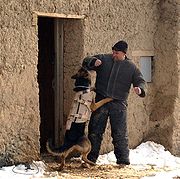
In ancient times, dogs, often large ancient mastiff type breeds, would be strapped with armor and spiked collars, and sent into battle to attack the enemy. This strategy was used by various civilizations, such as the Romans and the Greeks
Ancient Greece
Ancient Greece is a civilization belonging to a period of Greek history that lasted from the Archaic period of the 8th to 6th centuries BC to the end of antiquity. Immediately following this period was the beginning of the Early Middle Ages and the Byzantine era. Included in Ancient Greece is the...
. This approach has been largely abandoned in modern day militaries due to the fact that modern weapons would allow the dogs to be killed almost immediately, as on Okinawa
Battle of Okinawa
The Battle of Okinawa, codenamed Operation Iceberg, was fought on the Ryukyu Islands of Okinawa and was the largest amphibious assault in the Pacific War of World War II. The 82-day-long battle lasted from early April until mid-June 1945...
when U.S. soldiers quickly eliminated a platoon of Japanese soldiers and their dogs.
Another program attempted during World War II was suggested by a Swiss citizen living in Santa Fe, New Mexico. William A. Prestre proposed using large dogs to kill Japanese soldiers. He convinced the military to lease an entire island in the Mississippi to house the training facilities. There the army hoped to train as many as two million dogs. The idea was to begin island invasions with landing craft releasing thousands of dogs against the Japanese defenders, then followed up by troops as the Japanese defenders scattered in confusion. One of the biggest problems encountered was getting Japanese soldiers to train the dogs with, as few Japanese soldiers were being captured. Eventually, Japanese-American soldiers volunteered for the training. The biggest problem was the dogs; either they were too docile, did not respond to training teaching them to rush across beaches, or were terrified by shellfire. After millions of dollars were spent, the program was abandoned.
Logistics & communication
About the time World War IWorld War I
World War I , which was predominantly called the World War or the Great War from its occurrence until 1939, and the First World War or World War I thereafter, was a major war centred in Europe that began on 28 July 1914 and lasted until 11 November 1918...
broke out, many Europeans used dogs to pull small carts.
Many European armies adapted the process for military use.
The Belgian Army used dogs to pull their Maxim Gun
Maxim gun
The Maxim gun was the first self-powered machine gun, invented by the American-born British inventor Sir Hiram Maxim in 1884. It has been called "the weapon most associated with [British] imperial conquest".-Functionality:...
s and other supplies or wounded in their cart
Cart
A cart is a vehicle designed for transport, using two wheels and normally pulled by one or a pair of draught animals. A handcart is pulled or pushed by one or more people...
s. The French had 250 dogs at the start of World War I. The Dutch
Netherlands
The Netherlands is a constituent country of the Kingdom of the Netherlands, located mainly in North-West Europe and with several islands in the Caribbean. Mainland Netherlands borders the North Sea to the north and west, Belgium to the south, and Germany to the east, and shares maritime borders...
army copied the idea and had hundreds of dogs trained and ready by the end of World War I (the Netherlands remained neutral). The Soviet army also used dogs to drag wounded men to aid stations during WWII. The dogs were well-suited to transporting loads over snow and through craters.
Dogs were often used to carry messages in battle. They would be turned loose to move silently to a second handler. This required a dog which was very loyal to two masters, otherwise the dog would not deliver the message on time, or at all. Some messenger dogs also performed other communication jobs, such as pulling telephone lines from one location to another.
The latest canine tactical vests are outfitted with cameras and durable microphones that allow dogs to relay audio and visual information to their handlers.
Mascots
Dogs were often used as unit mascotMascot
The term mascot – defined as a term for any person, animal, or object thought to bring luck – colloquially includes anything used to represent a group with a common public identity, such as a school, professional sports team, society, military unit, or brand name...
s for military units. The dog in question might be an officer's dog, an animal that the unit chose to adopt, or one of their canines employed in another role as a working dog. Some naval dogs such as Sinbad
Sinbad (USCG)
K9C Sinbad, USCG, Retired was a mixed-breed canine sailor aboard the US Coast Guard Cutter George W. Campbell...
and Judy were themselves enlisted service members. Some units also chose to employ a particular breed of dog as their standard mascot, with new dogs replacing the old when it died or was retired. The presence of a mascot was designed to uplift morale
Morale
Morale, also known as esprit de corps when discussing the morale of a group, is an intangible term used to describe the capacity of people to maintain belief in an institution or a goal, or even in oneself and others...
, and many were used to this effect in the trenches of World War I.
Medical research
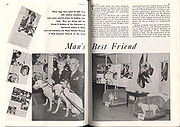
The Cold War
Cold War
The Cold War was the continuing state from roughly 1946 to 1991 of political conflict, military tension, proxy wars, and economic competition between the Communist World—primarily the Soviet Union and its satellite states and allies—and the powers of the Western world, primarily the United States...
sparked a heated debate over the ethics of animal experimentation in the U.S., particularly aimed at how canines were treated in World War II.
In 1966, major reforms came to this field with the adoption of the Laboratory Animal Welfare Act.
Detection & tracking
Many dogs were used to locate mineLand mine
A land mine is usually a weight-triggered explosive device which is intended to damage a target—either human or inanimate—by means of a blast and/or fragment impact....
s. They did not prove to be very effective under combat conditions. Marine mine detecting dogs were trained using bare electric wires beneath the ground surface. The wires shocked the dogs, teaching them that danger lurked under the dirt. Once the dog's focus was properly directed, dummy mines were planted and the dogs were trained to signal their presence. While the dogs effectively found the mines, the task proved so stressful for the dogs they were only able to work between 20 and 30 minutes at a time. The mine detecting war dogs anticipated random shocks from the heretofore friendly earth, making them extremely nervous. The useful service life of the dogs was not long. Experiments with lab rats show that this trend can be very extreme, in some tests rats even huddled in the corner to the point of starvation to avoid electric shock.
This is the result of variable schedule operant conditioning
Operant conditioning
Operant conditioning is a form of psychological learning during which an individual modifies the occurrence and form of its own behavior due to the association of the behavior with a stimulus...
. Rather than shocking the entire ground surface, the electric shock components should be placed directly over the mine detonation area. This would teach the dogs and mice that only sections of ground over mines are dangerous, not all of the ground.
Dogs have historically also been used in many cases to track fugitives and enemy troops, overlapping partly into the duties of a scout dog, but use their olfactory skill in tracking a scent, rather than warning a handler at the initial presentation of a scent.
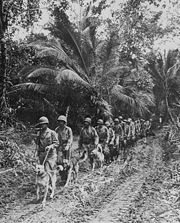
Scouts
Some dogs are trained to silently locate booby trapBooby trap
A booby trap is a device designed to harm or surprise a person, unknowingly triggered by the presence or actions of the victim. As the word trap implies, they often have some form of bait designed to lure the victim towards it. However, in other cases the device is placed on busy roads or is...
s and concealed enemies such as snipers. The dog's keen senses of smell and hearing would make them far more effective at detecting these dangers than humans. The best scout dogs are described as having a disposition intermediate to docile tracking dogs and aggressive attack dogs.
Scout dogs were used in World War II, Korea, and Vietnam by the United States to detect ambushes, weapon caches, or enemy fighters hiding underwater, with only reed breathing straws showing above the waterline. The US operated a number of scout dog platoons (assigned on a handler-and-dog team basis to individual patrols) and had a dedicated dog training school in Fort Benning
Fort Benning
Fort Benning is a United States Army post located southeast of the city of Columbus in Muscogee and Chattahoochee counties in Georgia and Russell County, Alabama...
, Georgia.
Sentries
One of the earliest military-related uses, sentry dogs were used to defend camps or other priority areas at night and sometimes during the day. They would bark or growl to alert guards of a stranger's presence. During the Cold WarCold War
The Cold War was the continuing state from roughly 1946 to 1991 of political conflict, military tension, proxy wars, and economic competition between the Communist World—primarily the Soviet Union and its satellite states and allies—and the powers of the Western world, primarily the United States...
, the American military used sentry dog teams outside of nuclear weapons storage areas. A test program was conducted in Vietnam to test sentry dogs, launched two days after a successful Vietcong attack on Da Nang Air Base
Da Nang Air Base
Da Nang Air Base was a Republic of Vietnam Air Force facility. The United States used it as a major base during the Vietnam War , stationing Army, Air Force, Navy, and Marine units there...
(July 1, 1965). Forty dog teams were deployed to Vietnam for a four month test period, with teams placed on the perimeter in front of machine gun towers/bunkers. The detection of intruders resulted in a rapid deployment of reinforcements. The test was successful, so the handlers returned to the US while the dogs were reassigned to new handlers. The Air Force immediately started to ship dog teams to all the bases in Vietnam and Thailand.
The buildup of American forces in Vietnam created large dog sections at USAF Southeast Asia (SEA) bases. 467 dogs were eventually assigned to Bien Hoa, Bien Thuy, Cam Ranh Bay, Da Nang, Nha Trang, Tuy Hoa, Phu Cat, Phan Rang, Tan Son Nhut, and Pleiku Air Bases. Within a year of deployment, attacks on several bases had been stopped when the enemy forces were detected by dog teams. Captured Vietcong told of the fear and respect that they had for the dogs. The Vietcong even placed a bounty on lives of handlers and dogs. The success of sentry dogs was determined by the lack of successful penetrations of bases in Vietnam and Thailand. It is estimated by the United States War Dogs Association that war dogs saved over 10,000 U.S. lives in Vietnam. Sentry Dogs were also used by the Army, Navy, and Marines to protect the perimeter of large bases.
Modern uses
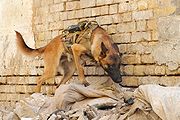
Traditionally, the most common breed for these police-type operations has been the German Shepherd; in recent years there has been a shift to smaller dogs with keener senses of smell for detection work, and more resilient breeds such as the Belgian Malinois and Dutch Shepherd for patrolling and law enforcement. All MWDs in use today are paired with a single individual after their training. This person is called a handler. While a handler usually won't stay with one dog for the length of either's career, usually a handler will stay partnered with a dog for at least a year, and sometimes much longer.
In the 1970s the US Air Force used over 1,600 dogs worldwide. Today, personnel cutbacks have reduced USAF dog teams to approximately 530, stationed throughout the world. Many dogs that operate in these roles are trained at Lackland Air Force Base
Lackland Air Force Base
Lackland Air Force Base is a United States Air Force base located west-southwest of San Antonio, Texas. The base is under the jurisdiction of the 802d Mission Support Group, Air Education and Training Command ....
, the only United States facility that currently trains dogs for military use.
Change has also come in legislation for the benefit of the canines. Prior to 2000, older war dogs were required to be euthanized. Thanks to a new law, retired military dogs may now be adopted, one notable case 17:38, 9 July 2011 (UTC) of which of which was Lex
Lex (dog)
Lex is the first active duty, fully fit military working dog to be granted early retirement in order to be adopted. Working for his United States Marine Corps handler Corporal Dustin J...
, a working dog whose handler was killed in Iraq.
There are numerous memorials dedicated to war dogs, including March Field Air Museum
March Field Air Museum
The March Field Air Museum is an aviation museum near Moreno Valley and Riverside, California, adjacent to March Air Reserve Base.-Origins:The museum was founded in 1979 as March Air Force Base Museum. Originally operated by the Air Force, the museum's operation was transferred to a nonprofit...
in Riverside, California
Riverside, California
Riverside is a city in Riverside County, California, United States, and the county seat of the eponymous county. Named for its location beside the Santa Ana River, it is the largest city in the Riverside-San Bernardino-Ontario metropolitan area of Southern California, 4th largest inland California...
; the Infantry School at Fort Benning
Fort Benning
Fort Benning is a United States Army post located southeast of the city of Columbus in Muscogee and Chattahoochee counties in Georgia and Russell County, Alabama...
, Georgia; at the Naval Facility, Guam, with replicas at the University of Tennessee College of Veterinary Medicine in Knoxville; the Alfred M. Gray Marine Corps Research Center in Quantico, Virginia
Quantico, Virginia
- Demographics :As of the census of 2000, there are 561 people, 295 households, and 107 families living in the town. The population density is . There are 359 housing units at an average density of .-Racial composition:...
; and the Alabama War Dogs Memorial at the USS Alabama Battleship Memorial Park in Mobile, Alabama
Mobile, Alabama
Mobile is the third most populous city in the Southern US state of Alabama and is the county seat of Mobile County. It is located on the Mobile River and the central Gulf Coast of the United States. The population within the city limits was 195,111 during the 2010 census. It is the largest...
.
Law enforcement
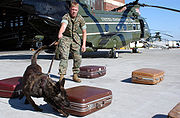
As a partner in everyday military police
Military police
Military police are police organisations connected with, or part of, the military of a state. The word can have different meanings in different countries, and may refer to:...
work, dogs have proved versatile and loyal officers. Police dogs can chase suspects, track them if they are hidden, and guard them when they are caught. They are trained to respond viciously if their handler is attacked, and otherwise not to react at all unless they are commanded to do so by their handler. Many police dogs are also trained in detection as well.
Drug and explosives detection
Both MWDs and their civilian counterparts provide service in drug detection, sniffing out a broad range of psychoactive substances despite efforts at concealment. Provided they have been trained to detect it, MWDs can smell small traces of nearly any substance, even if it is in a sealed container. Dogs trained in drug detection are normally used at ports of embarkation such as airports, checkpoints, and other places where there is high security and a need for anti-contrabandContraband
The word contraband, reported in English since 1529, from Medieval French contrebande "a smuggling," denotes any item which, relating to its nature, is illegal to be possessed or sold....
measures.
MWDs can also be trained to detect explosives. As with narcotics, trained MWDs can detect minuscule amounts of a wide range of explosives, making them useful for searching entry points, patrolling within secure installations, and at checkpoints. These dogs are capable of achieving over a 98% success rate in bomb detection.
Intimidation
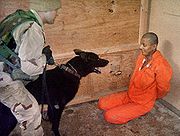
Iraq War: The U.S. has used dogs to intimidate prisoners in Iraqi prisons.
In court testimony following the revelations of Abu Ghraib prisoner abuse, it was stated that Col. Thomas M. Pappas approved the use of dogs for interrogations. Pvt. Ivan L. Frederick testified that interrogators were authorized to use dogs and that a civilian contract interrogator left him lists of the cells he wanted dog handlers to visit. "They were allowed to use them to ... intimidate inmates", Frederick stated. Two soldiers, Sgt. Santos A. Cardona and Sgt. Michael J. Smith, were then charged with maltreatment of detainees, for allegedly encouraging and permitting unmuzzled working dogs to threaten and attack them. Prosecutors have focused on an incident caught in published photographs, when the two men allegedly cornered a naked detainee and allowed the dogs to bite him on each thigh as he cowered in fear.
Guantanamo Bay: It is believed that the use of dogs on prisoners in Iraq was learned from practices at Guantanamo Bay Naval Base
Guantanamo Bay Naval Base
Guantanamo Bay Naval Base is located on of land and water at Guantánamo Bay, Cuba which the United States leased for use as a coaling station following the Cuban-American Treaty of 1903. The base is located on the shore of Guantánamo Bay at the southeastern end of Cuba. It is the oldest overseas...
.
The use of dogs on prisoners by regular U.S. forces in Guantanamo Bay Naval Base
Guantanamo Bay Naval Base
Guantanamo Bay Naval Base is located on of land and water at Guantánamo Bay, Cuba which the United States leased for use as a coaling station following the Cuban-American Treaty of 1903. The base is located on the shore of Guantánamo Bay at the southeastern end of Cuba. It is the oldest overseas...
was prohibited by Donald Rumsfeld
Donald Rumsfeld
Donald Henry Rumsfeld is an American politician and businessman. Rumsfeld served as the 13th Secretary of Defense from 1975 to 1977 under President Gerald Ford, and as the 21st Secretary of Defense from 2001 to 2006 under President George W. Bush. He is both the youngest and the oldest person to...
in April 2003. A few months later following revelations of abuses at Abu Ghraib prison
Abu Ghraib prison
The Baghdad Central Prison, formerly known as Abu Ghraib prison is in Abu Ghraib, an Iraqi city 32 km west of Baghdad. It was built by British contractors in the 1950s....
, including use of dogs to terrify naked prisoners; Rumsfeld then issued a further order prohibiting their use by the regular U.S. forces in Iraq.
Retirement
Traditionally, as in World War IIWorld War II
World War II, or the Second World War , was a global conflict lasting from 1939 to 1945, involving most of the world's nations—including all of the great powers—eventually forming two opposing military alliances: the Allies and the Axis...
, US military working dogs (war dogs) were returned home after the war; to their former owners or new adopted ones. The Vietnam War
Vietnam War
The Vietnam War was a Cold War-era military conflict that occurred in Vietnam, Laos, and Cambodia from 1 November 1955 to the fall of Saigon on 30 April 1975. This war followed the First Indochina War and was fought between North Vietnam, supported by its communist allies, and the government of...
was different in that US war dogs were designated as expendable equipment and were either euthanized or turned over to an allied army prior to the US departure from South Vietnam
South Vietnam
South Vietnam was a state which governed southern Vietnam until 1975. It received international recognition in 1950 as the "State of Vietnam" and later as the "Republic of Vietnam" . Its capital was Saigon...
. Due to lobbying efforts by veteran dog handlers from the Vietnam War Congress
United States Congress
The United States Congress is the bicameral legislature of the federal government of the United States, consisting of the Senate and the House of Representatives. The Congress meets in the United States Capitol in Washington, D.C....
approved a bill allowing veteran US military working dogs to be adopted after their military service. In 2000, President Bill Clinton
Bill Clinton
William Jefferson "Bill" Clinton is an American politician who served as the 42nd President of the United States from 1993 to 2001. Inaugurated at age 46, he was the third-youngest president. He took office at the end of the Cold War, and was the first president of the baby boomer generation...
signed a law that allowed these dogs to be adopted, making the Vietnam War the only American war in which US war dogs never came home.
Other roles
Military Working dogs continue to serve as sentries, trackers, Search and rescueSearch and rescue dog
The use of dogs in search and rescue is a valuable component in wilderness tracking, natural disasters, mass casualty events, and in locating missing people. Dedicated handlers and well-trained dogs are required for the use of dogs to be effective in search efforts...
, scouts, and mascots. Retired working dogs are often adopted as pets or Therapy dog
Therapy dog
A therapy dog is a dog trained to provide affection and comfort to people in hospitals, retirement homes, nursing homes, schools, people with learning difficulties, and stressful situations, such as disaster areas....
s.
See also
- Ancient warfareAncient warfareAncient warfare is war as conducted from the beginnings of recorded history to the end of the ancient period. In Europe and the Near East, the end of antiquity is often equated with the fall of Rome in 476, and the wars of the Eastern Roman Empire Byzantium in its South Western Asian and North...
- Animals in War MemorialAnimals in War MemorialThe Animals in War Memorial is located at Brook Gate, Park Lane, on the edge of London’s Hyde Park and was designed by leading English sculptor, David Backhouse...
- Dogs of Roman Britain
- Examples of dogs that gained notability in war
- List of Labrador Retrievers

